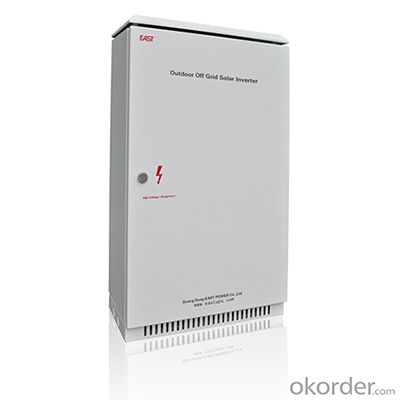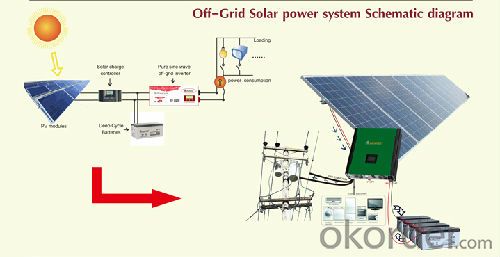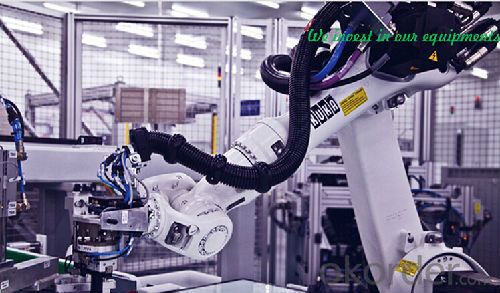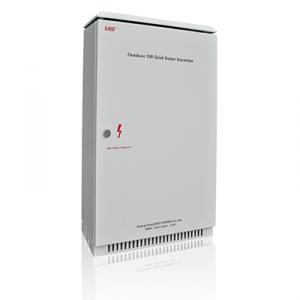Outdoor Off-Grid Solar Inverter 500W-2000W Specially Designed for Outdoor Communication Equipment
- Loading Port:
- China main port
- Payment Terms:
- TT or LC
- Min Order Qty:
- 1 pc
- Supply Capability:
- 1000 pc/month
OKorder Service Pledge
OKorder Financial Service
You Might Also Like
Outdoor Off-Grid Solar Inverter 500W-2000W
EA-GF outdoor series is specially designed for outdoor communication equipment, network equipment, traffic control systems; it is also for corner of the city, the countryside, and the mountains. The whole unit adopts high and low temperature resistance, corrosion resistance, dustproof, waterproof with multi-format mode, MPPT control, online regulation, short circuit protection, output frequency adaptable, output overload protection, battery charge management, monitoring, energy saving,environmental protection and other functions; This series of products can effectively ensure communication, network, traffic control equipment's power supply and operation stably, and be good partner of the outdoor communications equipment, network equipment, and traffic control systems.
● Special design for outdour use
● Multi-setting
※ Can adjust the use mode according to the configuration status and sun source status: PV priority or AC priority mode;
※ Can select the charging current based on the configured capacity of the battery.
● High reliability
※ Independent MPPT (Maximum Power Point Tracking) control microprocessor system
※ Independent inverter microprocessor control system
※ Many kinds of protection for overcharge, over-discharge, short-circuit, overload ect., and special PV reverse connection
protection as well
● Isolated and pure sine wave technology
● Advanced MPPT control system
● Intelligent charge management
● LED display mode
● Wide input range
● High-speed synchronous conversion
● Friendly alarm system
● Unattended and intelligent monitoring
● No-load off function (Option)
● Frequency auto sense
● Intelligent communication port (option)
Model | GF500-HW | GF1000-HW | GF1000-HW | GF1500-HW | GF2000-HW |
Power | 500W | 1000W | 1000W | 1500W | 2000W |
Battery Voltage | 24Vdc | 48Vdc | |||
Working Mode | PV(Photovoltaic priority) / AC (AC priority) Optional | ||||
PV | |||||
Input Voltage Range | 24Vdc – 45Vdc | 48Vdc – 90Vdc | |||
PV Panels Configuration (Suggestion) (vmp) | 30Vdc – 36Vdc | 60Vdc – 71Vdc | |||
PV Panels Configuration(Suggestion) (Imp≤rated current) | ≤40A | ≤60A | ≤40A | ≤60A | ≤80A |
Max Charge Current | 10-40A Optional | 10-60A Optional | |||
Max Transfer Efficiency | 98% | ||||
Display | |||||
Display Panel | LED | ||||
Mains Status(option) | |||||
Input Voltage Range | 100/110/120/220/230/240VAC±25%(customized) | ||||
Input Frequency Range | 45-65Hz (over this range transfer to inverter model auto.) | ||||
Output Voltage Range | 220Vac± 10% | ||||
MAX Input PF (AC/DC) | 98% | ||||
MAX Efficiency | 96% | ||||
MAX Charge Current | 12A Max( battery discharge ends; Start charging when PV charge current less than the set value) | ||||
AC Over Load | 110% load, after 255s, transfer to bypass,120% load ,after 60s transfer to bypass, 150% load, after 10s, transfer to bypass, auto recover after decrease load | ||||
Short Circuit | Input fuse / breaker | ||||
Inverter Output | |||||
Output Voltage | 220Vac± 5% | ||||
Output Frequency | 50 Hz / 60Hz ± 1% Auto. | ||||
Output PF | 1.0 | ||||
Distortion | Line load≤ 5% | ||||
PV-AC Transfer Time | 5 ms typical value; Max.8 ms | ||||
Max Efficiency | 84.5% | ||||
Nverter Overload | 110% load 255s shut down,120% load 60s shut down,150% load 1s shut down | ||||
No Load Off (Optional) | Load< 5% after 1min , transfer to bypass mode | ||||
Short Circuit | System Shut down automatically | ||||
AC Abnormal | Beeping 1/4s,auto silence after 40s | ||||
Alarm | |||||
Battery Low | Beeping 5/ 1s | ||||
Over Load | 1/ 1s | ||||
Communication Port (optional) | Rs232 / USB / SNMP(Setup available for regular start/shutoff) | ||||
Dry Contact | PV failure、battery low-voltage、overload、bypass、 inverter failure/ remote start generator dry contact signal | ||||
Others | |||||
Output Sockets | RS232/USB/SNMP(Setup available for regular start/shutoff) | ||||
Surge Protection | Class | ||||
EMC | CEN62040-2:2006;EN61000-3-2:2006; EN61000-3-3:2008 | ||||
IP Class | IP55 | ||||
Ambient Temperature | 0℃ ~ 40℃ | ||||
Ambient Humidity | 10℃ ~ 90℃ (Non Condensed) | ||||
Noise | ≤ 50dB | ||||
Working Altitude | 2000m(Every 100m increase derating 1%) | ||||
Inverter Size WxDxH(mm) | 280x600x900(with space for 2units 100A-200Ah battery) | 540x600x900 (with space for 4units 100A-200Ah battery) | |||
Packing Size WxDxH(mm) | 320x605x975 | 615x660x975 | |||
· Q. What is an UPS and What it is for ?
An uninterruptible power supply (UPS) is a device that allows your computer or telephone switch or critical equipement to keep running for at least a short time or longer time when the primary power source is lost. It also provides protection from power surges, spikes, brownouts, interference and other unwanted problems on the supported equipment.
· Q. How long the UPS to run when power goes?
This can take 3 paths.
1.You can pick a UPS that is rated for pretty much the full VA you need so it will be running at 100% of capability and will thus last 'n' minutes.
2.You can pick a UPS that is rated at a much higher VA value than you really need so, for example, is running at 50% of capability and will thus last for longer than the UPS from option 1.
3.You can use extra external battery packs to run for longer. If charging capability allows, the more and the bigger batteries you take with, the longer time UPS runs.
or using a generator after about 6 hours, it will be more cost-effective, with a short runtime UPS to bridge the generator start-up gap.






- Q:Can a solar inverter be used with a three-phase electrical system?
- Yes, a solar inverter can be used with a three-phase electrical system. In fact, many solar inverters are designed to work with three-phase systems. These inverters are capable of converting the direct current (DC) generated by the solar panels into alternating current (AC) that can be used by the three-phase electrical system.
- Q:Can a solar inverter be used with a solar-powered security camera system?
- Yes, a solar inverter can be used with a solar-powered security camera system. The solar inverter converts the DC (direct current) power generated by the solar panels into AC (alternating current) power, which can be used to power the security camera system. This setup allows for continuous and uninterrupted power supply to the security cameras, making them fully operational and independent of the electrical grid.
- Q:Can a solar inverter work in low light conditions?
- No, a solar inverter requires sufficient sunlight to convert the DC power generated by solar panels into usable AC power. In low light conditions, the solar inverter's efficiency decreases, and it may not be able to generate the required amount of electricity.
- Q:What is the typical size and weight of a solar inverter?
- The typical size and weight of a solar inverter can vary depending on the capacity or power rating of the system. However, in general, residential solar inverters are compact and lightweight, with dimensions around 14-18 inches wide, 20-24 inches tall, and 6-8 inches deep. Their weight usually ranges between 25-50 pounds. Commercial or utility-scale solar inverters, on the other hand, can be much larger and heavier, often weighing hundreds or even thousands of pounds.
- Q:Can a solar inverter be used with batteries?
- Yes, a solar inverter can be used with batteries. In fact, many solar energy systems use a solar inverter to convert the DC (direct current) power generated by solar panels into AC (alternating current) power that can be used by household appliances. By integrating batteries into the system, excess solar energy can be stored for later use during periods of low sunlight or at night, providing a reliable and continuous power supply.
- Q:How does a solar inverter handle voltage regulation?
- A solar inverter handles voltage regulation by continuously monitoring the incoming voltage from the solar panels and adjusting its output voltage accordingly. It ensures that the voltage produced by the solar panels is converted to the appropriate level for efficient use in the electrical system. This helps to maintain a stable and consistent voltage output, protecting the connected devices and optimizing energy conversion.
- Q:Can a solar inverter be used with solar-powered water pumps?
- Yes, a solar inverter can be used with solar-powered water pumps. A solar inverter is responsible for converting the direct current (DC) produced by solar panels into alternating current (AC) that can power electrical devices, including water pumps. This allows the solar panels to directly power the water pumps, making them suitable for off-grid or remote locations where access to electricity is limited.
- Q:Can a solar inverter be used with thin-film solar panels?
- Yes, a solar inverter can be used with thin-film solar panels. Thin-film solar panels have a different structure and composition compared to traditional crystalline silicon panels, but they still generate DC electricity that needs to be converted into AC for use in homes or businesses. A solar inverter is responsible for this conversion process, regardless of the type of solar panels used.
- Q:How does a solar inverter convert DC power to AC power?
- A solar inverter converts DC power to AC power by utilizing a two-step process. First, it converts the DC power generated by the solar panels into a high-frequency AC current. Then, it uses a transformer to increase the voltage and shape the AC waveform to match the grid's requirements. This process allows the solar energy to be fed into the electrical grid or used directly in homes and businesses.
- Q:Can a solar inverter be used in a solar-powered electric vehicle charging station?
- Yes, a solar inverter can be used in a solar-powered electric vehicle charging station. A solar inverter is responsible for converting the direct current (DC) generated by solar panels into alternating current (AC) which is suitable for use in electric vehicles. Therefore, it plays a crucial role in converting the solar energy into electricity that can be used to charge electric vehicles at the charging station.
1. Manufacturer Overview |
|
|---|---|
| Location | |
| Year Established | |
| Annual Output Value | |
| Main Markets | |
| Company Certifications | |
2. Manufacturer Certificates |
|
|---|---|
| a) Certification Name | |
| Range | |
| Reference | |
| Validity Period | |
3. Manufacturer Capability |
|
|---|---|
| a)Trade Capacity | |
| Nearest Port | |
| Export Percentage | |
| No.of Employees in Trade Department | |
| Language Spoken: | |
| b)Factory Information | |
| Factory Size: | |
| No. of Production Lines | |
| Contract Manufacturing | |
| Product Price Range | |
Send your message to us
Outdoor Off-Grid Solar Inverter 500W-2000W Specially Designed for Outdoor Communication Equipment
- Loading Port:
- China main port
- Payment Terms:
- TT or LC
- Min Order Qty:
- 1 pc
- Supply Capability:
- 1000 pc/month
OKorder Service Pledge
OKorder Financial Service
Similar products
New products
Hot products
Hot Searches
Related keywords
































